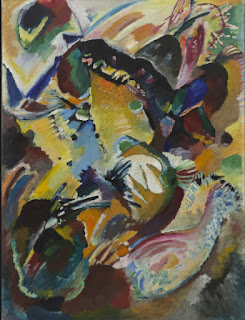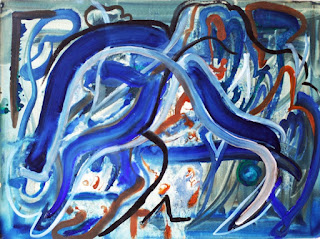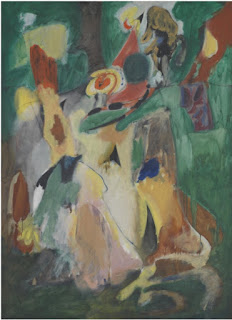This is an ongoing post - a place where abstract paintings of a certain kind will be posted as I stumble across them and discussed - or discussed again - as the spirit moves me.
Readers are invited to add their own comments.
*************
Kandinsky, Campbell Panel #2, 1914
I have a much better idea of how this kind of painting looks than what I might call it.
It’s a subset of Abstract Expressionism that is notably less personal and more spiritual. Though marks may always suggest a language and shapes may always resemble something— all possible associations are irrelevant, even counter-productive, to what this kind of painting is doing. It’s not about things, places, ideas, moods, memories, fears, desires, or even visions. The apparent subject is “The force that through the green fuse drives the flower” - whether intended as such or not - and it lives entirely in the painted surface, not in whatever associations may be made by the viewer.
Might we call them portraits of the Tao at both the macro and micro level ?
The Tao is the incomprehensible way things are - always changing, expanding in unexpected ways, infinite in complexity, interconnected throughout every scale from quark to galaxy. No familiarity with actual Taoist literature or practice is implied. An exhibition of "Taoism and the Arts of China" came through the Art Institute of Chicago twenty five years ago - and believe me, nothing like this could be found. It was much more tame.
It’s not just the spirit of life - it’s the spirit of being. No common phrase in European thinking comes to mind - though
Federico Faggin’s quantum information panpsychism is a compatible idea.
Bradley Walker Tomlin (1899-1953)
Each mark is added, not to clarify a feeling, but to amplify power and strangeness.
A pioneer of ABX who died way too young, I sure enjoy him more than Pollock and DeKooning.
The above is my favorite piece, but dammit, can’t find a title or date.
Joan Mitchell, Evenings on 73rd st. (Detail), 1957
Funky, neurotic , and exciting
Richard Poisette-Dart, Meditation on Drifting Stars, 1962
As gentle as a bloom of bacteria in a petri dish.
which does not mean that it cannot be terribly destructive.
Scott Wolniak, Current, 2014
Acrylic, ink, and watercolor on carved plaster, burlap , and plywood., 24 x 21
John Grillo, untitled, 1960
the shapes are larger so there's an evident sense of graphic design.
But still - each area seems to be erupting into its own direction.
Winnie Weiyun Szu
Monique Van Genderin
Alma Thomas untitled, 1962, 22 x 30, acrylic on paper
Esther Stocker
Alfonso Ossorio, Beachcombers (detail) 1953, 84 x 124
Alexander Rodchenko, Dance, 1915
Pavel Filonov, Victory over Eternity, 1920-21
Pavel Filonov, Composition, 1928
Mikhail Matiushkin, Extended Space, 1922-23, 27 x 38"
Bill Jensen, Locus, 39 x 32, 2001-3,
Mark Tobey, Written Over the Plains, 30 x 40, 1950
Samia Halaby, Prancing in the Vineyard, 1982, media on paper
Bruce Thorn, Night Song (detail)
Arshile Gorky, One Year the Milkweed, 38 x 48, 1944
Arshile Gorky, Waterfall, 1943, 60 x 44
the pulsation of nature as it throbs'…. Gorky






















































